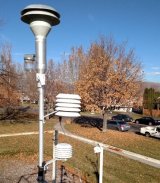EPA Research in Iowa
EPA researchers are working hard to protect communities across the nation. Learn about some of the work EPA researchers are doing in Iowa.
- Study Explores Ways to Improve Accuracy of Air Sensors
- Understanding How Environmental Factors Affect Children’s Asthma
- Treatment Options for PFAS-contaminated Stormwater
For more EPA work, see EPA in Iowa.

Study Explores Ways to Improve Accuracy of Air Sensors
Researchers and the public are using air sensors to fill the gaps in understanding local air quality. Despite the opportunities these air sensors provide to measure air pollutants, questions regarding their operations and performance capabilities remain. EPA scientists are working to improve the accuracy of sensors by generating mathematical equations to ‘correct’ the sensor data. Read Study Explores Ways to Improve Accuracy of Air Sensors.
Understanding How Environmental Factors Affect Children’s Asthma
In the United States, 6.2 million children are affected by asthma, and environmental factors such as air pollution, mold, and secondhand smoke can worsen common asthma symptoms. Research from the NIEHS/EPA Children’s Centers has increased understanding of what factors heighten asthma and what can be done to help children. The University of Iowa Children’s Environmental Airway Disease Center researched how children who live in rural communities are impacted by the agricultural settings surrounding them. Read Understanding How Environmental Factors Affect Children’s Asthma.
Treatment Options for PFAS-contaminated Stormwater
In January 2023, fire fighters used an aqueous film forming foam (AFFF) containing PFAS to extinguish a fire in Marengo, Iowa. The foam entered the stormwater collection system, resulting in an estimated twelve million gallons of PFAS-contaminated stormwater being held in a basin. Iowa Department of Natural Resources (DNR) contacted EPA Office of Research and Development (ORD) for help identifying options for treating the contaminated water. ORD and Iowa DNR staff discussed the appropriate technologies. ORD researchers then ran models to estimate the effectiveness of the technologies, the optimal flow rates needed, and the length of time it would take to treat the total volume of water.
